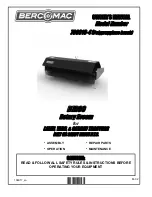
GIRA
Info
Powernet Built-In Fourfold IR Sensor
Installation Instructions
Powernet Built-In Fourfold IR Sensor
12/97
Page 2 of 3
14-16
10-13
1-4
5-9
[mm]
illustration
e
Installation Sequence:
1. Drill a 13 mm hole into the intermediate ceiling.
2. Set the clamping spring of the IR receiver to
ceiling thickness (refer to illustration
e
).
3. Insert the receiver supply cable with its four wire
ends into the hole.
4. Insert the receiver into the drilled hole and turn
fully anticlockwise.
5. Put the power unit on the intermediate ceiling.
Connect the receiver supply line. Connect the
power supply and the load line as shown in the
diagram (illustration
c
).
To remove the receiver, withdraw it from the drilled hole by turning anticlockwise.
Extraneous light may only indirectly shine on the IR receiver as, otherwise, its sensitivity will be
reduced.
Adjustment
The function of the device depends upon the software used.
The number of channels is determined by the application chosen.
By means of the IR receiving sensor, the functions of switching, dimming, louver control and
transmitter can be performed.
Warning
Caution! The installation and assembly of electrical equipment may only be performed by a
skilled electrician. The line between the receiver and the built-in device carries 230 V potential.
Non-observance of these notices can cause fire hazards or other dangerous situations.
Specifications
Supply
Mains voltage
: 230 V AC (sine-wave)
Mains frequency
: 50 Hz
Connection
Mains
: Plug-in terminals up to 2.5 mm² max.
Receiver
: Plug-in terminals
Receiver
Diameter
: 46 mm,
18 mm up
Hole
: 13 mm
Intermediate ceiling thickness
: 1 to 16 mm
Receiver line length
: Approx. 75 cm (ready-made)
Transmission medium
: Infrared light
Wavelength :
λ
= 950 nm
Carrier frequency
: 455 kHz
Coding
: PPM code, carrier-frequency based
Ambient temperature
: -5 °C to +45 °C
Protective system
: IP 20
Dimensions (in mm)
: 39.5 x 28.5 x 278.6 (W x H x L)





















